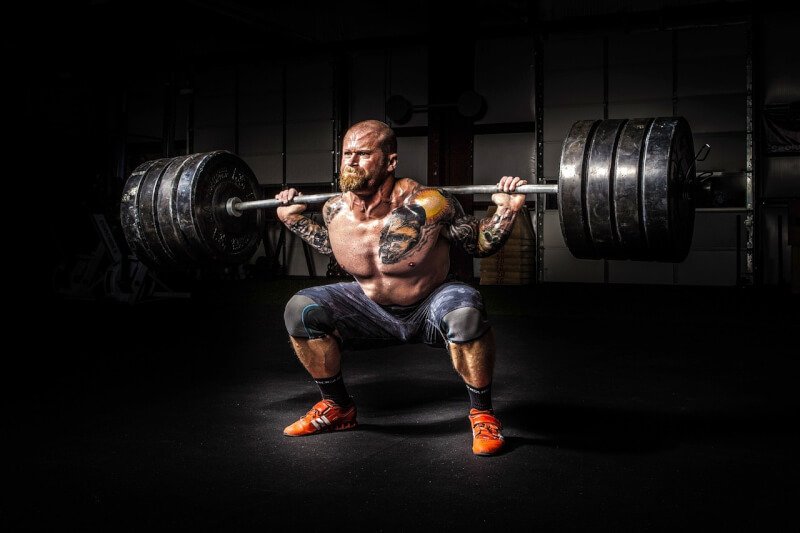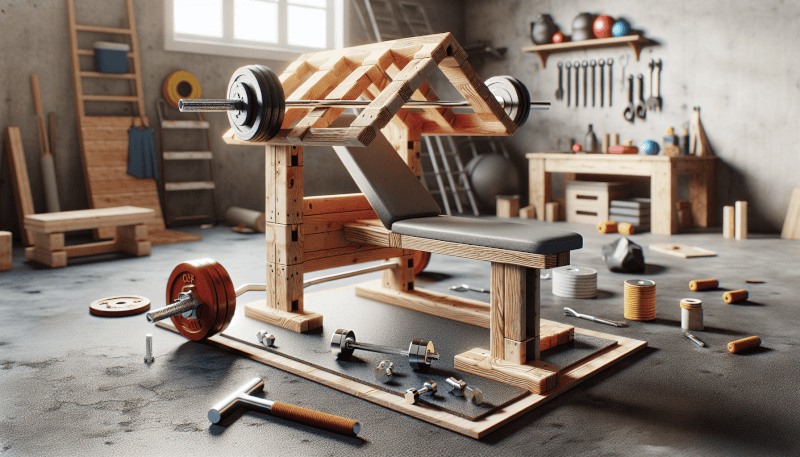Have you ever wished you could have a workout bench in your own home gym, without the hefty price tag? Look no further! In this article, we will guide you through the process of creating your very own DIY Home Gym Bench. With easy-to-follow steps and clear instructions, you’ll be able to build a sturdy and functional bench in no time. Say goodbye to expensive fitness equipment and say hello to your new, affordable and personalized workout space right in the comfort of your own home. Let’s get started!
1. Planning and Design
1.1 Assessing your space
Before diving into building your own home gym bench, it’s important to assess the space you have available. Measure the area where you plan to place the bench to ensure it fits comfortably and allows for proper movement. Consider factors such as ceiling height, surrounding furniture, and access to electrical outlets if you plan on incorporating adjustable features.
1.2 Determining your needs
Next, determine your specific needs for the gym bench. Are you primarily focused on weightlifting and need a sturdy bench for bench presses and other exercises? Or do you want to incorporate adjustable features for incline and decline exercises? Assessing your fitness goals and exercise routines will help you determine the features and design elements you’ll need for your bench.
1.3 Sketching the design
Once you have assessed your space and determined your needs, it’s time to sketch out a design for your home gym bench. Start by drawing a rough diagram of the bench, including dimensions and any adjustable features you plan to incorporate. This will serve as a blueprint for your project and help you visualize the final product.
1.4 Gathering necessary materials
Before you start building, gather all the necessary materials for your DIY home gym bench. This includes lumber for the frame and seat, screws or nails for assembly, sandpaper for sanding the wood, paint or stain for finishing, and any additional materials needed for adjustable features or attachments. Make a list of all the materials you’ll need and gather them in one place to ensure a smooth construction process.
2. Preparing the Materials
2.1 Measuring and cutting the wood
With your materials gathered, it’s time to start preparing them for assembly. Begin by measuring and cutting the wood according to the dimensions outlined in your design sketch. Use a measuring tape, pencil, and saw to accurately cut the wood to the required lengths. Take your time with this step to ensure precise measurements for a sturdy and well-built bench.
2.2 Sanding the edges
After cutting the wood, it’s important to sand the edges to smooth out any rough surfaces. This will prevent splinters and create a more polished look for your home gym bench. Use sandpaper or a handheld sander to carefully sand all the edges of the wooden pieces. Pay special attention to corners and joints to ensure a comfortable and safe user experience.
2.3 Drilling holes for screws
To assemble the bench, you’ll need to drill holes for screws or nails to secure the wooden pieces together. Use a drill with an appropriate drill bit to create pilot holes in the wood. These pilot holes will prevent the wood from splitting when the screws are inserted. Take care to align the holes properly to ensure a strong and secure frame for your gym bench.
2.4 Painting or staining the wood
If you want to add a touch of color or protect the wood, consider painting or staining the wooden surfaces before assembly. Choose a paint or stain that is suitable for indoor use and compatible with your design aesthetic. Apply the paint or stain evenly using a brush or roller, following the manufacturer’s instructions. Allow the paint or stain to dry completely before moving on to the next step.

3. Assembling the Frame
3.1 Attaching the legs
Begin assembling the frame by attaching the legs to the seat platform. Position the legs at the corners of the seat and use screws or nails to secure them in place. Make sure the legs are aligned properly and level with the seat platform. Use a level to double-check for stability and make any necessary adjustments before proceeding.
3.2 Connecting the supports
To add stability and strength to the frame, connect the support pieces between the legs. These support pieces can be attached horizontally or diagonally, depending on your design preferences. Use screws or nails to secure the supports to the legs and seat platform. Reinforce the connections by adding additional screws or nails as needed.
3.3 Reinforcing with bracing
For added stability, consider reinforcing the frame with bracing. Bracing involves adding additional pieces of wood diagonally between the legs and supports. These diagonal pieces will prevent the frame from wobbling or collapsing during use. Attach the bracing securely using screws or nails, making sure they are flush with the other wooden pieces.
3.4 Ensuring stability and levelness
Before moving on to the next steps, it’s crucial to ensure that the frame is stable and level. Use a level to check for any unevenness and make adjustments as needed. Sit on the bench and test its stability by applying pressure. If the bench feels wobbly or uneven, reinforce the connections or make necessary adjustments until you achieve a stable and level frame.
4. Creating the Seat
4.1 Cutting and attaching the seat boards
Now it’s time to create the seat for your home gym bench. Cut the seat boards according to the dimensions outlined in your design sketch. Arrange the boards on top of the seat platform and attach them securely using screws or nails. Make sure the boards are evenly spaced and aligned properly for a comfortable and functional seat surface.
4.2 Adding cushions or padding
For added comfort, consider adding cushions or padding to the seat surface. Measure and cut foam or thick padding to fit the dimensions of your seat boards. Attach the cushions or padding securely using adhesive or fabric straps to prevent slipping during use. This will provide a more comfortable experience while using the bench for various exercises.
4.3 Upholstering the seat for comfort
If you prefer a more aesthetically pleasing and finished look, you can choose to upholster the seat. Measure and cut upholstery fabric according to the dimensions of the seat boards, leaving extra fabric for folding and stapling. Wrap the fabric tightly around the cushions or padding, folding and stapling it securely to the underside of the seat boards. Trim any excess fabric for a clean and polished look.
4.4 Securing the seat to the frame
To complete the seat assembly, secure the seat boards to the frame using screws or nails. Make sure the seat is centered and aligned properly with the frame. Double-check for stability by sitting on the bench and applying pressure. If the seat feels loose or unstable, reinforce the connections or make necessary adjustments to ensure a secure and comfortable seat.

5. Building the Backrest
5.1 Cutting and attaching the backrest boards
Now it’s time to build the backrest for your gym bench. Cut the backrest boards according to the dimensions outlined in your design sketch. Attach the boards to the frame securely using screws or nails. Make sure the backrest is aligned properly and level with the seat surface for ergonomic support during exercises.
5.2 Adding additional support
For added strength and stability, consider adding additional support to the backrest. This can be done by attaching a piece of wood vertically between the backrest boards and the frame. Use screws or nails to secure the additional support, ensuring it is flush with the backrest and frame for a sturdy structure.
5.3 Finishing the backrest surface
To create a comfortable and visually appealing backrest, consider adding padding or cushions. Measure and cut foam or thick padding to fit the dimensions of the backrest boards. Attach the cushions securely using adhesive or fabric straps. If desired, upholster the backrest using upholstery fabric, following the same steps as for the seat upholstery. This will provide additional comfort and a finished look to your DIY home gym bench.
6. Adding Adjustable Features
6.1 Installing an adjustable incline
If you want to incorporate adjustable incline features into your gym bench, determine the mechanism you’ll use and follow the manufacturer’s instructions for installation. This may involve adding adjustable hinges or brackets to the backrest, allowing you to adjust the angle of the backrest according to your exercise needs. Make sure to test the stability and functionality of the adjustable incline before use.
6.2 Incorporating a decline feature
For those who prefer a decline feature, consider adding an adjustable footrest to your gym bench. This can be achieved by attaching a separate piece of wood to the frame at the foot end of the bench. Use hinges or brackets to allow for adjustable positioning, ensuring the footrest securely locks into place at the desired decline angle.
6.3 Creating adjustable seat positions
To accommodate different exercise positions and user preferences, consider adding adjustable seat positions to your gym bench. This can be achieved by adding slots or notches to the sides of the seat platform, allowing for the attachment of an adjustable seat mechanism. Follow the manufacturer’s instructions for installing and adjusting the seat mechanism, ensuring proper stability and functionality.

7. Installing Attachments
7.1 Attaching resistance bands
If you plan on incorporating resistance training into your workouts, consider installing attachment points for resistance bands. Attach hooks or brackets to the sides or underside of the bench, allowing for easy and secure attachment of resistance bands. This will add versatility to your workouts and allow for targeted muscle strengthening.
7.2 Adding hooks for resistance training
In addition to attaching resistance bands, you can also add hooks to your gym bench for resistance training with cables or free weights. Attach sturdy hooks to the frame or underside of the bench, ensuring they are capable of safely supporting the weight used during exercises. This will provide you with more options for strength training.
7.3 Installing a power rack attachment
If you have a power rack or cage in your home gym, consider installing a power rack attachment to your bench. This will allow you to safely and securely use the bench within the confines of the power rack, adding an extra layer of safety during heavy lifts. Follow the manufacturer’s instructions for installing and using the power rack attachment.
8. Finishing Touches
8.1 Sanding and smoothing all surfaces
Before considering the final finishing touches, take the time to sand and smooth all surfaces of your DIY home gym bench. Use sandpaper or a handheld sander to remove any rough patches or imperfections. Pay attention to edges, corners, and areas that will come into contact with the user’s body for a comfortable and safe user experience.
8.2 Applying protective finishes
To protect the wood and enhance its appearance, consider applying a protective finish to your gym bench. This can be a clear varnish, polyurethane, or any other suitable wood finish. Apply the finish according to the manufacturer’s instructions, ensuring even coverage and allowing sufficient drying time between coats. A protective finish will prolong the lifespan of your bench and maintain its aesthetic appeal.
8.3 Adding padding or cushions
For extra comfort and support, consider adding padding or cushions to the armrests or any other areas of the bench that come into contact with the user’s body. Measure and cut foam or thick padding to fit the desired areas, and secure them using adhesive or fabric straps. This will provide a more enjoyable and comfortable workout experience.
8.4 Personalizing the bench with decor
To add a personal touch to your DIY home gym bench, consider decorating it with decals, stickers, or other forms of personalization. This can include motivational quotes, your name or initials, or any other designs that inspire you during your workouts. Get creative and make your gym bench a unique reflection of your personality and fitness journey.

9. Safety Precautions
9.1 Ensuring proper weight capacity
Before using your home gym bench, ensure that it is capable of supporting your weight and the weights you plan to use during workouts. Check the weight capacity of the materials used and reinforce any connections or supports as necessary. Always prioritize safety and avoid exceeding the weight capacity of your bench.
9.2 Checking for stability before use
Before each use, check the overall stability of your gym bench. Ensure that all connections, screws, and joints are secure and tight. Test the stability by applying pressure and sitting on the bench. If any instability or wobbling is detected, reinforce the connections or make necessary adjustments before using the bench for exercises.
9.3 Regularly inspecting for damages
To maintain the safety and integrity of your DIY home gym bench, regularly inspect it for any damages or signs of wear and tear. Check for loose screws, cracked wood, or any other issues that may compromise the stability or safety of the bench. Address any damages promptly by repairing or replacing the affected parts.
9.4 Using proper form and technique
Lastly, always prioritize proper form and technique when using your home gym bench. This will help prevent potential injuries and maximize the effectiveness of your exercises. Consult fitness resources or a personal trainer for guidance on correct form and technique for various exercises performed on the bench. Listen to your body, start with lighter weights, and gradually increase the intensity as you build strength and confidence.
10. Maintaining and Upgrading
10.1 Cleaning and maintaining the bench
To keep your home gym bench in optimal condition, regularly clean and maintain it. Dust off any debris, wipe down surfaces with a damp cloth, and use wood cleaner or mild soap if necessary. Avoid using harsh chemicals that may damage the finish or upholstery. Regular maintenance will help prolong the lifespan of your bench and ensure a safe and enjoyable workout experience.
10.2 Inspecting and replacing worn parts
Over time, certain parts of your gym bench may become worn or damaged. Regularly inspect the bench for any signs of wear and tear, such as loose screws, cracked wood, or frayed upholstery. Address any issues promptly by replacing worn parts or making necessary repairs. This will ensure the continued safety and functionality of your bench.
10.3 Upgrading with additional features
As your fitness goals evolve, you may want to upgrade your home gym bench with additional features or attachments. This can include adjustable features, enhanced padding, or adding new attachments for different exercise variations. Assess your needs and consult fitness resources or professionals for guidance on the best upgrades for your bench. Upgrading your bench will allow you to continue challenging yourself and diversifying your workout routine.
In conclusion, building your own DIY home gym bench can be a rewarding and cost-effective way to enhance your home workout space. By following these comprehensive steps and taking necessary safety precautions, you can create a functional, sturdy, and personalized gym bench that meets your specific needs. Enjoy the process of building your bench and reap the benefits of a convenient and versatile home gym setup.



